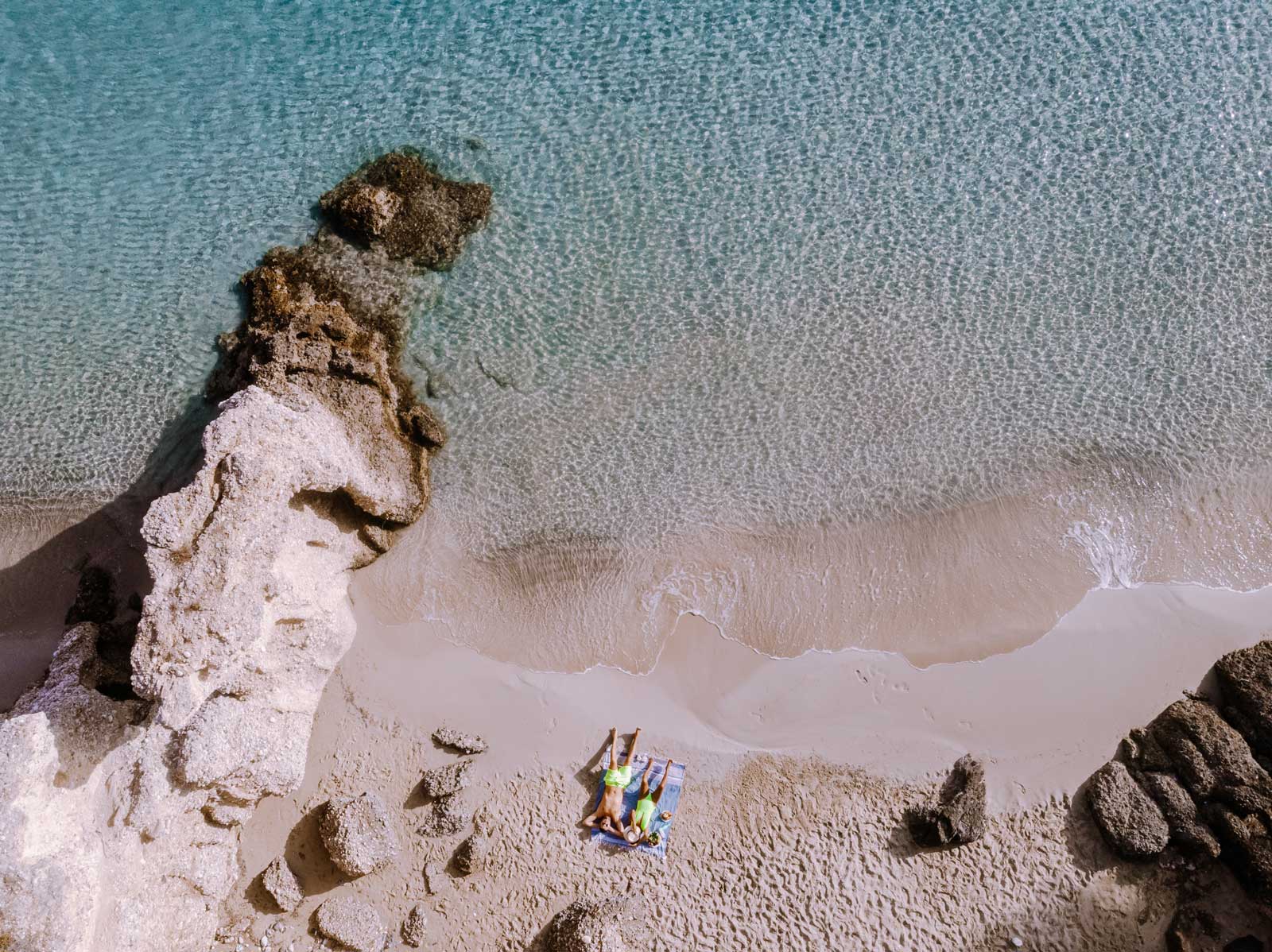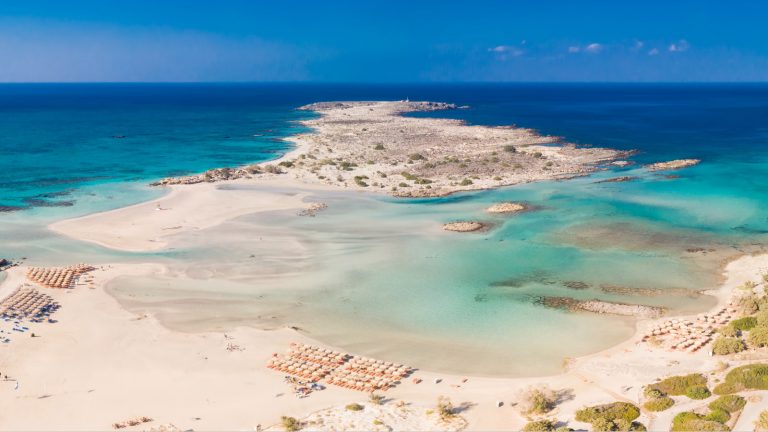
ELAFONISSI
Elafonissi (meaning “Deer Island” in Greek) is a magnificent, rare beach – essentially a tropical beach – in the southwest of Chania region. The beach is in a distance of about 75 km from Chania city. In the area there is the beach of Elafonissi, the Elafonissi islet, and the picturesque lagoon in between, the three of them creating an amazing natural landscape, known all over Europe.
The beach has shallow, crystal-clear turquoise water, and its fine sand is white and pink, the pink color coming from the abundance of seashells in the area. The whole surrounding area of Elafonissi is environmentally protected by the Natura 2000 Environmental Program. The area hosts, among many other unique species, rare species of cedar trees that grow on the sand, and many migratory birds. For many visitors to Crete, Elafonissi is the most iconic, must-visit beach on the island, which also provides spectacular photo opportunities. Although it is relatively far from Chania city, the good condition of the road leading there makes a visit to Elafonissi easy for any traveler.
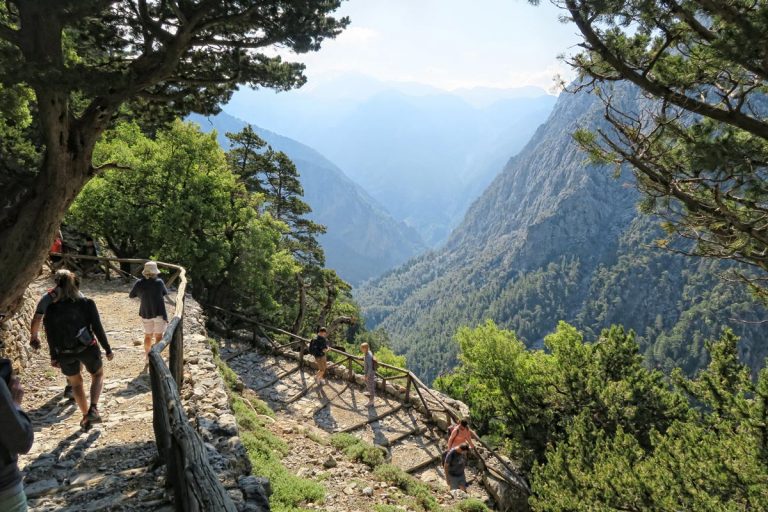
SAMARIA GORGE
Samaria Gorge is the most famous natural formtion in Crete. It is located in the South of Chania region, in the Sfakia area, in a distance of about 45 km from Chania city. Samaria Gorge is the longest gorge in Europe, with a total length of 16 km. It is the biggest among many spectacular gorges in the White Mountains of Crete, or Lefka Ori.
The gorge has one of the most unique floras and faunas in Europe, with rare wildflowers and animal species like the rare wild goat of Crete, Kri Kri. The gorge was declared a National Park in 1962. The entrance to the gorge is at its highest point at Xyloskalo, in an altitude of more than 1.200 m, and the exit is at the beach of Agia Roumeli. You need about 5-6 hours to pass through Samaria Gorge. Close to the exit of the gorge you pass through what is considered its most special point for many visitors: The Iron Gates, or “Sidiroportes” in Greek, the narrowest part of the gorge – about only 3 m wide – and one of the deepest – the sides of the gorge have a height of about 500 m here. As a final note, remember that hiking across Samaria Gorge is allowed only between May and October, as during winter months there are sometimes streams running through the gorge, which are dangerous for hikers.
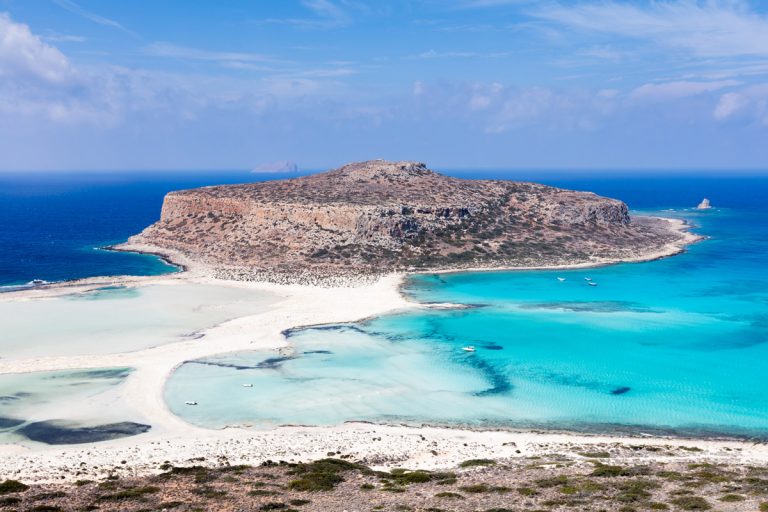
BALOS
Balos is one of the best beaches not only in Crete, but in Greece in general. In fact, Balos beach is a tropical lagoon in Chania region. The beach is located northwest of Chania city, on the north of Gramvousa Peninsula. The road to Balos beach is not in good condition, and only accessible if you have a 4×4 vehicle, or an appropriate motorcycle.
For most visitors, the easiest way to get to Balos is by boat from the small harbour of Kissamos. But the jaw-dropping beach will reward you for any small hassle to get there. Balos beach has characteristic white and pink sand and many seashells – which have given their pink color to the sand. The water is shallow, crystal-clear and warm, as Balos is a lagoon. The beach is very well protected from the winds, and the water is always calm. Before starting your trip to the magnificent Balos beach, make sure to take sunscreen and anything else that will protect you from the sun, as there are not any trees or shade in the area.
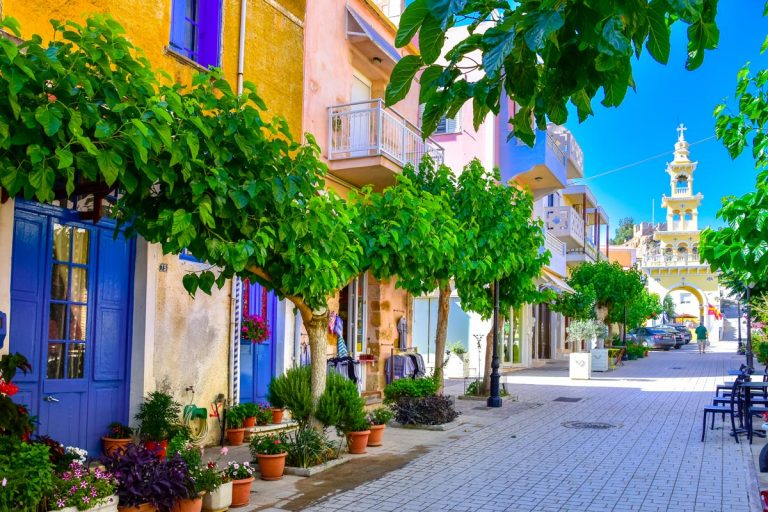
PALEOCHORA
Paleochora is the biggest village in the south of Chania region. It is in a distance of about 75 km southwest of Chania city, the road being in excellent condition. The village is built on a perfect location, on a peninsula overlooking two large bays with beautiful beaches.
The two beaches inside Paleochora are great, and organized, with sun beds and parasols. But that’s not all: On the coast around the village, with a total length of 18 km, there are more than 10 excellent beaches to choose from, all of them with crystal-clear water. Probably the most known of them are Platia Ammos, Chalikia, Psilos Volakas and Krios. Apart from its splendid beaches, many visitors are drawn to Paleochora by its authentic atmosphere of a beautiful seaside village of South Crete, as originally did the hippies in the ‘60s, who first discovered the charms of Paleochora.
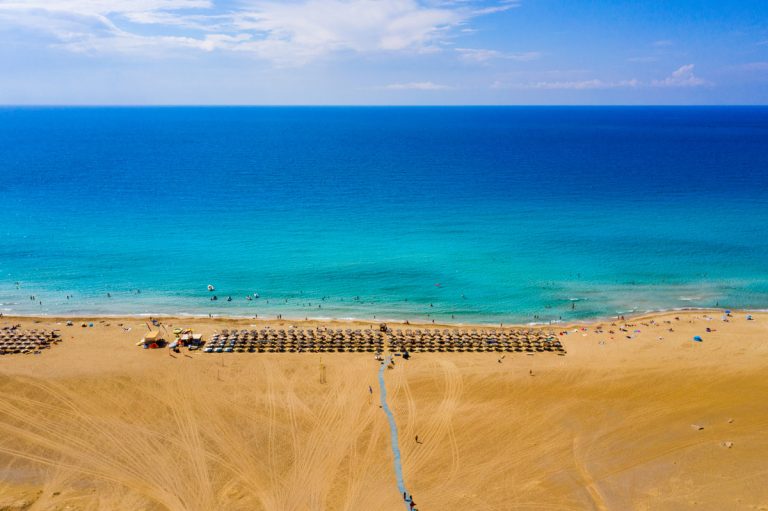
FALASARNA
Falasarna is blessed with one of the best beaches in Crete. It is located in the northern part of the west coast of Crete, in a distance of about 45 km west of Chania city. The road from Chania city to Falasarna is in excellent condition. Falasarna is essentially a large coast with white sand and crystal-clear water, lying between high mountains.
Both the beach and the surrounding natural environment are stunning. In Falasarna coast, there are three distinct beaches. The first in the southern part of the coastal zone, called “Pachia Ammos”, is organized and has sun beds and parasols. The second beach is located close to the first and to the north, being the main beach of Falasarna, also with sun beds and parasols, and with a beach bar. The third beach is a little further to the north, on the end of the paved road along the coastline. This beach is the most remote – and the most unique – of the three, and you will also find a nice tavern here. The Falasarna beaches look to the west, offering you magical sunsets when the sun is gently “falling” into the clear water of the Cretan sea. A last thing you should keep in mind, is that, when there are heavy winds blowing from the west, it may be difficult to swim in Falasarna beaches.
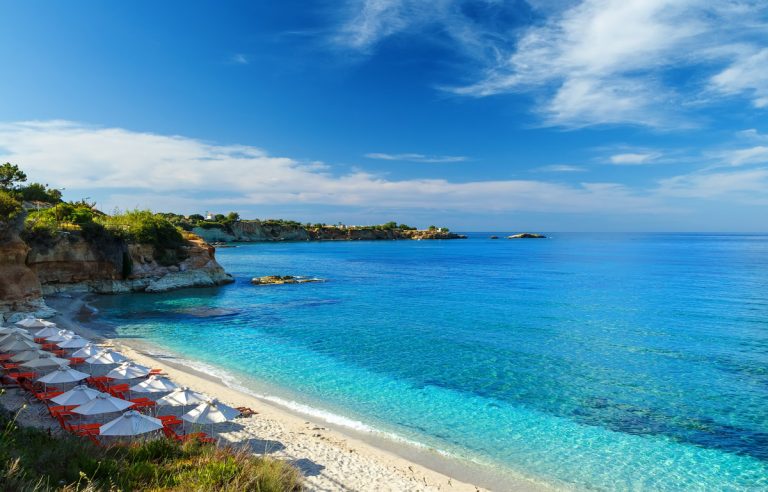
SARANTARI
Sarantari is the most known beach in the Sarantaris cove. It is in a distance of 27 km east of Heraklion, close to Hersonissos, and has taken its name from the scenic chapel of St. George Sarantaris in the area. The beach has perfect fine sand and shallow turquoise water, and is ideal for families with kids. It is close to the main road, but you have to get down a short but steep path to get there.
The beach is well protected from northwest winds and is always calm. Close to the main Sarantari beach, there are other smaller beaches in the small bays that are formed in the area, like Gefyri and Limanakia. One of them is a nudist beach, well protected from both the winds and prying eyes.
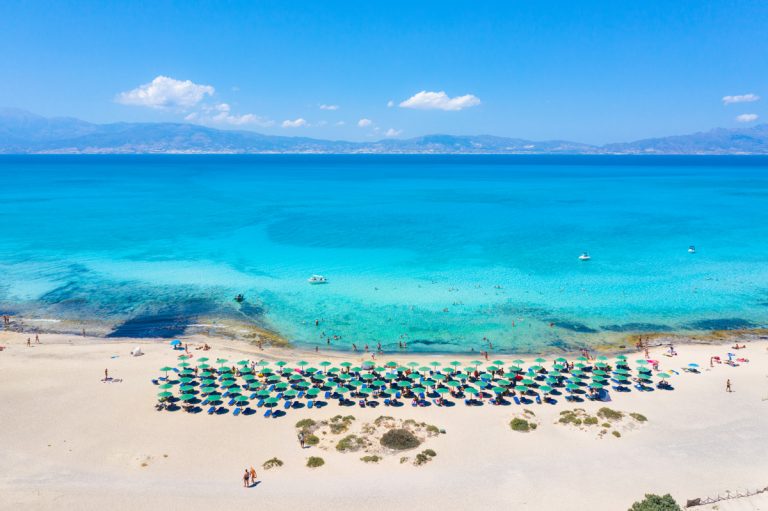
CHRISI ISLAND
Chrisi Island is one of the “hidden secrets” of Crete that amaze most visitors. It is located in the southeast of the island, close to Ierapetra, in a distance of about 15 km from mainland Crete. “Chrisi” means “golden” in Greek, and that is absolutely true for the main beach of the island, which is called golden beach. It is a magnificent beach with crystal-clear blue water, fine white and pink sand, colored form the seashells in the area, and beautiful junipers making a landscape that seems more tropical than Mediterranean.
Although golden beach is the most known in Chrisi, there are also other good beaches on the island, like Vlychadia beach. You can get to the island by boat from Ierapetra – the boat leaves in the morning and returns in the afternoon between May and October. Chrisi island is an environmentally protected area, and most trees there have an age of 200 years, some of them being up to 300 years old.
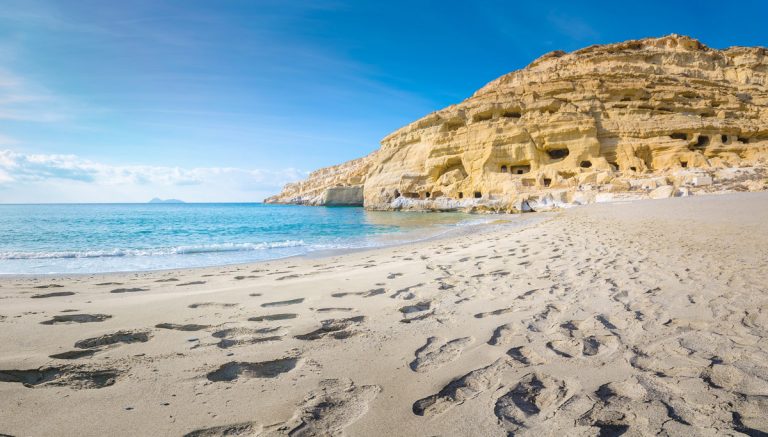
MATALA
Matala is one of the most famous beaches in Crete. It is located about 70 km southwest of Heraklio, on the south coast of the island. Matala beach is an idyllic beach with a length of about 300 m and with deep, crystal-clear water. The location was very important through history, as it was the port of the powerful ancient Minoan city of Phaistos, and then it became the port of the big ancient city of Gortys until the Roman times.
On the cliffs on the northern side of the beach you can find the Neolithic caves that were carved in the stone. These caves became famous all over the world in the 60’s, as they attracted the first hippies on the island, who used them for accommodation. Today, there are no hippies in Matala, but their legacy lives on. The beach is well organized with sun beds and parasols, and there are plenty of beautiful cafes, bars and taverns next to it.
